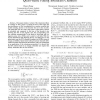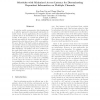157 search results - page 11 / 32 » On the Equivalence of Two Achievable Regions for the Broadca... |
CORR
2007
Springer
13 years 8 months ago
2007
Springer
— This paper studies a variant of the classical problem of “writing on dirty paper” in which the sum of the input and the interference, or dirt, is multiplied by a random var...
SUTC
2006
IEEE
2006
IEEE
Schedules with Minimized Access Latency for Disseminating Dependent Information on Multiple Channels
14 years 2 months ago
In wireless mobile environments, data broadcasting is an effective approach to disseminate information to mobile clients. In some applications, the access pattern of all the data...
DCC
2009
IEEE
14 years 3 months ago
2009
IEEE
The multicasting of an independent and identically distributed Gaussian source over a binary erasure broadcast channel is considered. This model applies to a one-to-many transmiss...
PIMRC
2008
IEEE
14 years 2 months ago
2008
IEEE
— We consider the problem of rate allocation in a fading Gaussian multiple-access channel with fixed transmission powers. The goal is to maximize a general concave utility funct...
VTC
2006
IEEE
14 years 2 months ago
2006
IEEE
Abstract— In a fading broadcast channel (BC), Queue Proportional Scheduling (QPS) is presented via geometric programming (GP). Given the current queue state, QPS allocates a data...


